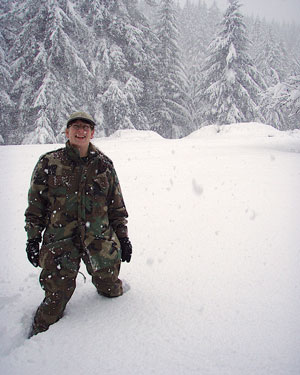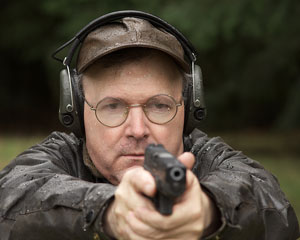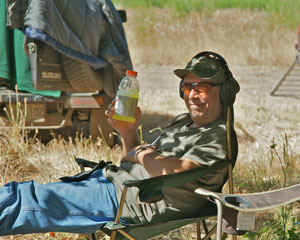It rains so much here, in fact, that there is a common refrain among shooting instructors: “If it ain’t rainin’, it ain’t trainin’!”
Macho posturing aside, resigning oneself to the necessity of firearms training in bad weather is one thing, but liking it is another thing entirely. I don’t like being wet and cold because it definitely affects what I do and how I do it. It also affects my mental state and my ability to concentrate on the task at hand.
Does this have an implication for our defensive training? You’d better believe it does!
Some Definitions
Many people use the terms “training” and “practice” interchangeably, when they are two different concepts.
Training is education. It is an exposure to new information and, in the case of defensive shooting, it’s usually an exposure to new physical skills. To train means to learn something new, something about which you were previously unfamiliar. You train to assimilate different information than what you already possess, or to habituate a new skill.
Practice, on the other hand, is to revisit or rehearse something you’ve already learned. Practice is done to increase understanding or become more competent. You practice what you’ve trained in order to get better — whatever “better” means in relation to what you’re doing.
Why the distinction? Because the difference between training and practice is important when we’re talking about the weather. It doesn’t matter if we’re talking about rain and cold or sun and very high temperatures. Training in extreme weather imposes some significant limitations on what we can do, unless we take steps to mitigate the problems.
Is the Weather Really Important?
Learning something new, be it intellectual (information) or physical (a motor skill) requires a certain amount of concentration. It requires that you are in a receptive state of mind and can devote the mental resources necessary to internalize and recall the lessons learned.
Think of it this way: have you ever tried reading a difficult book, one that you need or want to read but find difficult to understand? How much harder is it when you’re distracted by kids or noise from the neighbors or even a meowing house cat? How about if your chair is uncomfortable or your head hurts or you’re hungry?

Yes, it’s possible you might need to shoot under these conditions -- but how easy would it be to learn something new during a snowstorm?
Now let’s take that outside, onto the range, where you’re wet and cold and your feet hurt and you’re tired. Under those conditions, you’ll likely find it harder to pay attention to what the instructor is saying, and harder to muster the resolve to do everything right when you’re doing the drills.
In short, it’s much easier to learn a new skill when your environment is closer to a moderate ideal. When the temperature is 72 degrees with hazy sunshine and a slight breeze, it’s easy to pay attention and stay motivated. Take the temperature up to 95 degrees and raise the humidity to 75%, and you’ll probably find yourself struggling to get through the material you’re being presented.
All in all, I’d rather learn a new skill — train, in other words — in nice weather than in inclement weather.
Practice Makes Perfect, Even If the Weather Isn’t
Once I’ve learned a skill, however, I want to practice it in all the plausible conditions I might face. As I mentioned at the top, here in Oregon it’s often wet and cold. If I’m going to be competent with my skills, I need to practice them under conditions where I am likely to need them, and that means I need to be able to execute those skills when wet and cold.
If all I do is practice under ideal conditions (or in an artificial climate-controlled environment), I may find that my skills degrade in the less-than-ideal conditions in which I spend the majority of my time. It’s important to practice skills in context; that is, under the conditions they are likely to be needed. If that means snow and a parka or bright sun and sweat, you should always be practicing your skills in plausible conditions.
This is why I made the distinction between training and practice. If the conditions under which you train are less than ideal, you run the risk of not fully grasping the material for later practice. If you practice under conditions that don’t reflect the world in which you live, you run the risk of your development being incomplete.
It’s relatively easy to pick the conditions under which you practice — you just wait for a good or a bad day, as the case may be. But when you’re training, you’re at the mercy of the weather on the day your class is scheduled. How can you make sure that you minimize those personal distractions and get the most out of your class?

Your training day might not be perfect. Preparation is important in order to get the most out of it!
First Step: Prepare!
The first thing is to figure out what the conditions are likely to be on class day. If you’re flying in from out of the area, it’s a good idea to consult a “local” before you leave home. Find out what the forecast is, but also what outliers you can expect. Here in the Pacific Northwest, it’s not unusual for a forecast 68-degree day to unexpectedly turn out to be 48 degrees and raining. It’s happened to me more than once!
Rain
Once you know what the weather is likely to be, as well as what it could possibly be, make sure you have clothing suitable for the occasion. In my neck of the woods, that means always having rain gear in the car. If there’s a possibility of rain, make sure you have not only a raincoat but also a waterproof hat that will accommodate your chosen hearing protection.
If you’re facing rain, it’s important to consider a layer of insulating clothing underneath your rain jacket. Even if it’s relatively warm and I’m not getting my skin wet, I’ve found that rain will chill me. A lightweight fleece jacket under that rain gear will make all the difference in the world.
While I don’t normally wear gloves to shoot, my hands will get cold very quickly if it’s wet. I keep a pair of cheap fleece mittens or gloves in the pockets of my raincoat and put them on during the downtime between shooting drills. When the instructor is lecturing or giving instructions, it’s a great time to don gloves and warm your hands!
Snow
It’s unusual for most instructors to schedule classes during known snowy weather, but sometimes the unexpected happens. In general, the same thing goes for snow as rain, except you should also make sure to bring insulated boots and thick wool socks.
Heat and Sun
In hot weather, dress in relatively light and airy fabrics. A white long-sleeved cotton dress shirt makes a full day under the sun significantly more pleasant. The long sleeves keep my arms from getting burned, and the all-cotton fabric gives good evaporative cooling. The white color reflects a substantial portion of the heat, keeping me cool overall.
Wicking underwear, the kind designed for workout use, is a godsend when perspiration is expected. Combine it with lightweight pants and you’ll be able to concentrate on the lesson without being preoccupied by chafing!
Naturally a hat is important, and most ranges these days require one. Again, make it lightweight, breathable, and light colored.

Staying hydrated is critically important in intense heat. Drink plenty of water, and drink frequently.
Hydration
Don’t forget to drink! You’ll perspire and burn calories even in cold weather, and it’s important for both your physical and mental health to drink frequently. A thermos of something warm is very satisfying in cold weather. An occasional sip of hot chocolate or tea does wonders for one’s attitude! The rest of the time, I suggest water and/or an occasional fruit juice.
When the temperature goes up, it’s especially important to stay hydrated. I tell my students to plan on a minimum of two liters of cool water per person, more if the temperature goes up or the class is physically intensive. Bring your own — it’s unusual for a range to provide water or other drinks.
Speaking of other drinks, stay away from caffeinated and carbonated beverages. Drinking plain water and fruit juice or electrolyte replacements in roughly a two-to-one ratio works very well over a long day of training.
Oh, and don’t forget sunscreen for your face and the back of your neck.
Break Time!
Most instructors I know are keen on providing plenty of rest time for students. It’s important that students have frequent downtime to allow them to decompress a little. A tired student not only doesn’t get the full benefit from the material, he or she also doesn’t pay close attention to safety.
When I teach under less-than-ideal conditions, I increase the number and frequency of rest breaks. Whether it’s cold or hot, students need more opportunities to get out of the elements and allow their bodies and minds to rest. I use my own comfort level as a guide, but also pay attention to the body language of my students. Do they look as though they need a break? If so, I give them one!
If your instructor isn’t providing sufficient break time for you to stay engaged and “on task,” tell him! Most instructors will realize that if you’re getting fatigued, so are others, and will adjust the schedule accordingly.
What if your instructor gives you a hard time or, worse, berates you in front of other students for your decision? Frankly, I’d demand my money back and leave! You weren’t drafted into that class, and you’re not required to put up with that kind of treatment. If your instructor won’t be professional of his own accord, it’s up to you to force him to be.
Shared Responsibility
Your comfort is dependent upon both you and your instructor. It’s his job to make sure you have plenty of opportunities for rest, but it’s your responsibility to make sure he understands that you — and the people around you — need those opportunities. Work together to make your experience, and that of the other students in class, the best it can be under whatever environmental conditions you’re training!



A friend and I took an NRA class that included shooting a few years back. When we got to the range there was a light sprinkle, the instructor said, You don't get to pick the time, place or weather of a defensive shooting, get ready. So we shot, after we passed the test, he asked if we had more ammo, of course we did. We shot another 250 rounds, different scenarios, from concealment, multiple round, multiple targets, distanced, with movement and the longer we shot, the more and harder it rained. The most fun I have ever had in a training class. And he was right, performance in a dry square box on a well lit range is going to be a lot easier than the real world with wind and rain or snow in your face.
I can recall an outdoor shoot and training session that I had with my 20something son. During our outing in the high Desert in northern Arizona, the sky went black, the temperature plummeted and it began to snow... sideways! My son said "what do you think dad? Do you want to call it and head back in?" I said "nope. A bad situation seldom waits for perfect conditions to happen and you need to be able to react and hit your targets even in bad weather. " He agreed and we had a wonderful bad weather training day where we went over things like breath control, trigger press, and how to maintain control of your pistol while you're shivering uncontrollably. These skills may prove to be real world life savers in a bad situation, or in inclement weather. You may decide to take in a movie with your girl in your short sleeve t-shirt and jeans just to find out after the movie that the temperature turned cold and it has begun to rain, or snow and THIS is the time that a bad guy, or group of bad guys has decided to mug, rob, carjacking (or worse) one of you, or both of you in the dark secluded parking lot behind the theater. In a situation like this, you're going to need to be able to defend yourself and your girl (perhaps with terminal intent) in order to survive the situation and live to tell the story of your ordeal another day. The practice was priceless! Now, as a soldier in the Army in Afghanistan, he tells me how glad he was that I took the time to train with him in crappy conditions! He tells me that these are more often than not the "normal" types of conditions that he encounters over there and that he is so glad he learned to "fight through cold, wind, rain, or discomfort". He says when other guys in his platoon begin to shiver and shake and their teeth begin to chatter, he closes his eyes-slows his breathing and centers himself to the task at hand giving him the focus and the determination to push himself further and harder than he ever thought possible! Today is Veteran's Day weekend and I pray for his safe return! Thanks for the informative article!